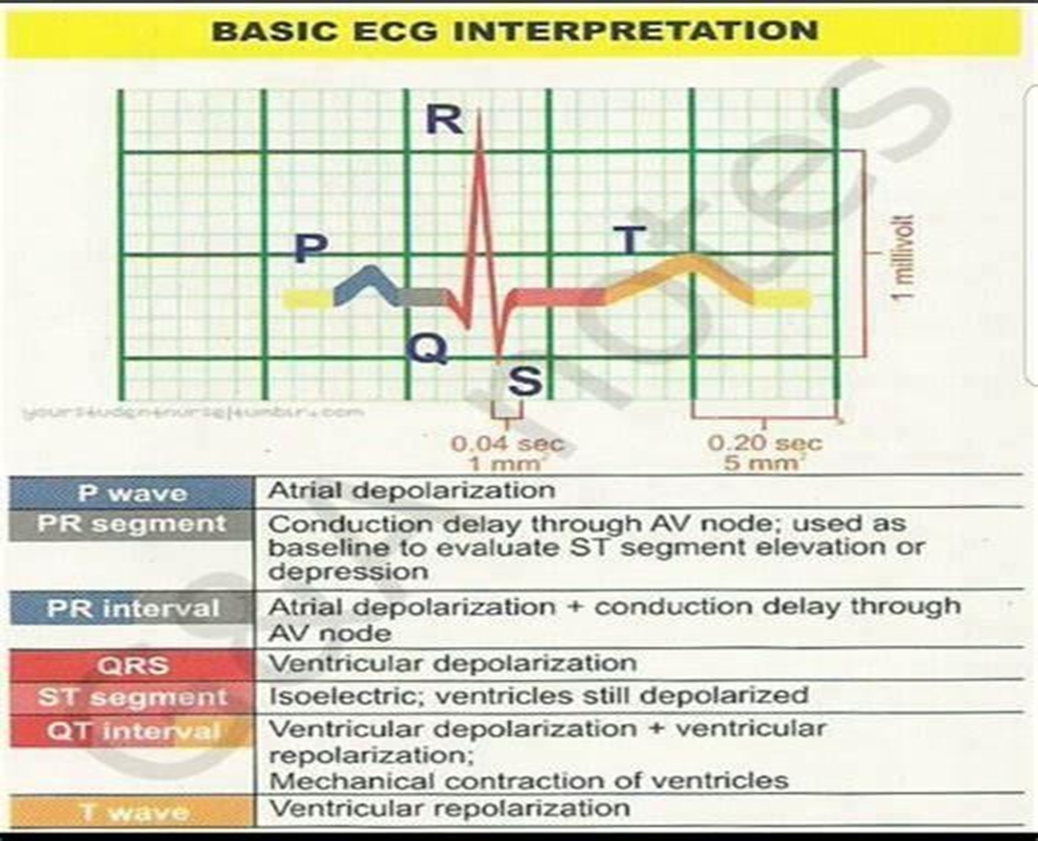A nurse is interpreting a client's ECG strip. Which of the following components of the ECG should the nurse examine to determine the time it takes for ventricular depolarization and repolarization?
QRS complex
QT interval
ST segment
PR interval
The Correct Answer is B
B. The QT interval represents ventricular depolarization and repolarization. It starts at the beginning of the QRS complex and ends at the end of the T wave. The QT interval reflects the total time it takes for both ventricular depolarization and repolarization to occur. Prolongation of the QT interval can be associated with an increased risk of arrhythmias, including torsades de pointes.
A. The QRS complex represents ventricular depolarization, which is the electrical activation of the ventricles. The duration of the QRS complex provides information about the time it takes for ventricular depolarization to occur. A prolonged QRS complex can indicate abnormalities in ventricular conduction, such as bundle branch blocks or ventricular hypertrophy.
C. The ST segment represents the early part of ventricular repolarization. It starts at the end of the QRS complex and ends at the beginning of the T wave. Changes in the ST segment, such as elevation or depression, can indicate myocardial ischemia or injury.
D. The PR interval represents the time it takes for the electrical impulse to travel from the atria to the ventricles. It includes atrial depolarization, atrial contraction, and the delay at the atrioventricular node. The PR interval does not specifically provide information about ventricular depolarization and repolarization.

Nursing Test Bank
Naxlex Comprehensive Predictor Exams
Related Questions
Correct Answer is D
Explanation
D Normal saline bolus administration is indicated for hypovolemia or inadequate intravascular volume, which can lead to decreased cardiac output and hypotension. In this scenario, the client has an amber urine output of 45ml in the last 3 hours, indicating decreased urine output and potential hypovolemia. The elevated blood pressure (170/67 mmHg) suggests possible volume overload or fluid retention, but the decreased urine output raises concerns for inadequate intravascular volume. Therefore, administering a normal saline bolus may be the first priority to optimize intravascular volume and improve cardiac output.
A Isosorbide mononitrate is a vasodilator commonly used in the treatment of heart failure and angina. It helps reduce preload and afterload, thereby decreasing the workload on the heart. However, in this scenario, the client's blood pressure is elevated (170/67 mmHg), and there is no indication of acute decompensation or pulmonary congestion. Therefore, isosorbide PO may not be the first priority medication at this time.
B Nitroglycerin is a potent vasodilator commonly used to manage acute heart failure exacerbations and acute coronary syndromes. It helps reduce preload and afterload, improving cardiac output and relieving symptoms of heart failure. In this scenario, the client's blood pressure is elevated, but the heart rate is normal, and there are no signs of acute decompensation. Therefore, initiating a nitroglycerin drip may not be the first priority unless the client develops symptoms of acute decompensation or pulmonary congestion.
C Dopamine is a vasopressor medication that can be used to increase blood pressure and cardiac output in patients with hypotension or shock. However, in this scenario, the client's blood pressure is elevated (170/67 mmHg), and there is no evidence of hypotension. Therefore, initiating a dopamine drip may not be appropriate at this time and could potentially exacerbate hypertension.
Correct Answer is A
Explanation
A. A heart murmur typically indicates turbulent blood flow through a heart valve. This turbulence can occur due to various reasons, such as valve stenosis (narrowing), regurgitation (leakage), or structural abnormalities of the valves. The turbulent flow produces audible sounds that can be heard with a stethoscope during cardiac auscultation.
B. A heart murmur is not caused by blood entering an inflexible chamber. Instead, it is caused by turbulent blood flow through the heart valves. The sound produced by this turbulent flow may vary depending on the underlying pathology of the valve.
C. While heart murmurs can be described based on their characteristics (such as high-pitched or low- pitched), the presence of a heart murmur does not necessarily indicate a narrow valve. Murmurs can occur due to various valve abnormalities, including stenosis (narrowing) or regurgitation (leakage). The pitch and quality of the murmur may vary depending on the underlying pathology and the location of the abnormality.
D. A heart murmur is not typically associated with inflammation around the heart. While inflammation of the heart (such as myocarditis or pericarditis) can cause symptoms and abnormal sounds, these conditions would not be described specifically as a "heart murmur."
Whether you are a student looking to ace your exams or a practicing nurse seeking to enhance your expertise , our nursing education contents will empower you with the confidence and competence to make a difference in the lives of patients and become a respected leader in the healthcare field.
Visit Naxlex, invest in your future and unlock endless possibilities with our unparalleled nursing education contents today
Report Wrong Answer on the Current Question
Do you disagree with the answer? If yes, what is your expected answer? Explain.
Kindly be descriptive with the issue you are facing.
